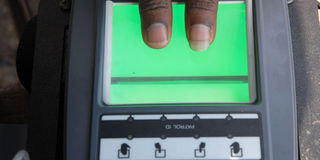Time ripe for national database of fingerprints

A voter has his finger prints taken during a past voter registration process. PHOTO | FILE |
What you need to know:
- People change their names too, especially women when they get married.
- Humans, as well as apes and monkeys, have so-called friction ridge skin covering the surfaces of their hands and feet.
- Without a national database of finger prints in which to compare fingerprints collected at scenes of crime, it can be a daunting forensic exercise for detectives.
Our names and personal numbers offer a time-tested and relatively efficient means to represent our identity.
But our names and telephone or post office box numbers are effective only to the degree that they are unique, permanent, consistent, and unambiguously bonded to our physical selves.
We know they are not necessarily unique. If you type your name on Google Search, you will find tens or hundreds of people with a name as yours. People change their names too, especially women when they get married.
Likewise, people change their physical address. You can count how many times you have changed your telephone numbers. In this age of sophisticated crimes, it is imperative that national institutions maintain an authentic database of their people.
This is where modern biometrics, such as finger printing come in. Biometrics are our most unique physical and behavioural features that can be practically sensed by devices and interpreted by computers so that they may be used as proxies of our physical selves in the digital realm.
In this way we can tie digital data to our identity with permanency, consistency, and unambiguity, and retrieve that data using computers in a rapid and automated fashion. You may have experience that many companies including banks, health insurance companies and voter registration systems keep finger prints as a means of personal identification.
Humans, as well as apes and monkeys, have so-called friction ridge skin covering the surfaces of their hands and feet. Friction ridges comprises a series of ridges and furrows that provide friction to aid in grasping and prevent slippage.
These ridges are unique and permanent — no two individuals including identical twins have the exact same ridge arrangement. Moreover, the arrangement of the ridges and features do not change throughout our lifetimes, with the exception of significant damage that creates a permanent scar.
This makes them suitable as long-term markers of human identity and may be employed by police or other authorities to pinpoint individuals who wish to conceal their identity, or to identify people who are incapacitated or deceased and thus unable to identify themselves, as in the aftermath of a natural disaster or tragedy like the recent one at Garissa University College.
Just imagine if we had a well monitored finger printing technology (and other surveillance systems) at the gates of the Garissa University College to authenticate staff and students from visitors.
HARDER
It would have been harder for criminals to enter the campus and butcher our brothers and sisters.
The Government has also proposed to register all Kenyans afresh taking their finger prints and other biometric information to ensure that instances of criminals inclined to cheat their way into the national database by buying or forging national identity cards with ulterior motives, including terrorism can be minimised.
Although there has been some dissenting voices on how this would be implemented, this is a laudable move and would ease the work of the detectives who visit scenes of crime to take finger prints.
Without a national database of finger prints in which to compare fingerprints collected at scenes of crime, it can be a daunting forensic exercise for detectives.
There are however challenges in fingerprint identification of infants, the elderly, and individuals with worn fingerprints due to manual labour.
Strategies employed to prevent the exclusion of services to these individuals include connecting an infant’s record to the fingerprints of their legal guardians and enrolling multiple fingerprints for manual labourers and the elderly to increase matching accuracy, as well as using secondary identification tags, such as their name or location, as a backup.
Sam Wambugu is a monitoring and evaluation specialist; [email protected]





